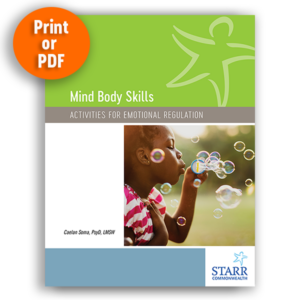What is a sensory-based intervention or strategy?
Sensory-based strategies involve any five senses: Sight, hearing, smell, taste, and touch—the central nervous system changes based on the input of various sensations. When a child of any age is engaged in learning and can complete tasks, their central nervous system is regulated and balanced. However, when a child is having difficulty with learning, engaging with peers and adults, or has behavior that prevents them from functioning well at school or home, their central nervous system is dysregulated in some way. It is either in a state of hyper-arousal where you might see a child unable to sit still, pay attention, or express defiance or aggression. Or perhaps you might observe a child who is in a dysregulated state of hypo-arousal, where you might observe a child who refuses to participate, ignores direction, withdraws, isolates, or spends a lot of time sleeping or numbing by misusing electronic devices or substances.
Engaging children in sensory-based strategies can help re-regulate their nervous system regardless of the dysregulation. This happens because sensory-based strategies target the brain’s area responsible for heart rate, muscle tension, and respiration (breath). Based on the stimulus received, these brain functions can be re-regulated (either slowed down or sped up). For example, if a child can’t sit still, allowing them to go for a walk or use their hands to draw or solve a puzzle will help exert some of their energy and calm their nervous system down. For a child who is disengaged and lethargic, taking a cold drink of water or intentionally noticing the environment around them will stimulate their nervous system to be more alert.
- Sensory-based strategies you can use today:
- What do you see?
Invite the child to notice their surroundings. Ask them to identify all the objects around them, naming them out loud. (i.e., clock, desk, coffee mug, pencil, notebook). As a variation, ask the child to notice all the objects around them of a particular color. (i.e., name all the red objects you see.) - Trace your hand.
Ask the child to straighten their arms in front of them with their palms facing down and spread out their fingers. Then, ask if they are left or right-handed. With the dominant hand’s pointer finger, tell the child to trace around each edge of the non-dominant hand with their finger. Repeat this several times. - Sensory pathways.
Create a pathway on the floor using stickers or sticky notes with instructions for children to follow. For example, hop on one foot, two jumps forward, arms stretched out, skip for three counts, march in place, etc. - Walk, run, or do jumping jacks in place.
- Tension and Relaxation.
Invite the child to notice various muscles in their body. Guide them to tighten and then relax each muscle. (I.e., fists, biceps, glutes, toes). Repeat several times. - Offer headphones.
Offer headphones that cancel out all noise or allow for listening of calming music. - Hand on chest, hand on belly
Ask the child to place one hand on their chest and the other on their belly either when seated or standing. Then, invite them to take a few breaths and notice where they feel the breath. Repeat. You can ask the child to take a few deep breaths and then finish with a few normal breaths. - Provide a drink of water or a small mint or hard candy if the child is old enough and choking is not a potential risk.
Sensory-based strategies can be implemented to support children in successful learning and behavior. Rather than getting frustrated with disengaged children or not behaving in ways that keep them on task and interacting successfully with others, notice the dysregulation. Once you see the dysregulation, you can determine what the child might need most to regain a balanced state in their nervous system.

Download this activity from our Mind Body Skills Guidebook for FREE!


